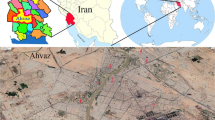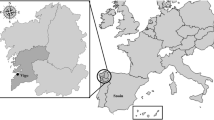Abstract
Some biological particles present in the atmosphere, such as pollen grains, give rise to human health problems, allergies, and infections. In view of the recognized special allergenic ability of Plantago pollen grains, a model based on an artificial neural network (ANN) was developed in this work in order to forecast the Plantago airborne pollen concentration. The proposed model uses data from Plantago pollen and the main meteorological variables recorded during 16 years (1993–2008) in the city of Ourense (northwest Spain). Its accuracy was tested during the years 2009 and 2010 with a prediction horizon of 2 days in advance. The model was applied in the atmosphere of the city of Ourense (Spain). Obtained results show that ANN model provides good results against other classical mathematical methodologies, which do not convergence so well. The forecasted pollen concentrations here are applied to allergology because they allow taking into account preventive measures in risk pollinosis suffers population.





Similar content being viewed by others
References
Andersen, T. B. (1991). A model to predict the beginning of the pollen season. Grana, 30, 269–275.
Arenas, L., González de la Cuesta, C., Tabarés, J. M., Iglesias, I., Jato, V., & Méndez, J. (1996). Sensibilización cutánea a pólenes en pacientes afectos de rinoconjuntivitis-asma en la población de Ourense en el año 1994–1995. In Proceedings of the 1st European Symposium on Aerobiology (93–94).
Arizmendi, C. M., Sánchez, J. R., Ramos, N. E., & Ramos, G. J. (1993). Time series predictions with neural sets: Application to airborne pollen forecasting. International Journal of Biometeorology, 37, 139–144.
Asero, R., Mistrello, G., Roncarolo, D., & Casarini, M. (2000). Detection of allergens in plantain (Plantago lanceolata) pollen. Allergy, 55, 1059–1062.
Astray, G., Galvez, J. F., Mejuto, J. C., Moldes, O. A., & Montoya, I. A. (2013a). Esters flash point prediction using artificial neural networks. Journal of Computational Chemistry, 34(5), 355–359.
Astray, G., Iglesias-Otero, M. A., Moldes, O. A., & Mejuto, J. C. (2013b). Predicting critical Micelle concentration values of non-ionic surfactants by using artificial neural network. Tenside, Surfactants, Detergents, 50(2), 118–124.
Belmonte, J., Roure, J. M., & March, X. (1998). Aerobiology of Vigo, North-Western Spain: Atmospheric pollen spectrum and annual dynamics of the most important taxa, and their clinical importance for allergy. Aerobiologia, 14, 155–163.
Blanco, B., Camazón, B., Valencia, R., Vega, A., Asturias, J., & Fernández González, D. (2008). Plantago sensitisation in León city (NW Spain). Allergy, 63(Supplement 88), 549.
Bricchi, E., Frenguelli, G., Mincigrucci, G., Fornaciari, M., Ferranti, F., & Romano, B. (1995). Time linkages between pollination onsets of different taxa over an 11-year period in Perugia, Central Italy. Aerobiologia, 11, 57–61.
Calabozo, B., Barber, D., & Polo, F. (2001). Purification and characterization of the main allergen of Plantago lanceolata pollen, Pla l 1. Clinical and Experimental Allergy, 2, 322–330.
Carretero, P., Juste Picón, S., García González, F., Alloza Gómez, P., Pérez Giménez, R., Blanco Carmona, J., et al. (2005). Pólenes alergénicos y polinosis en la ciudad de Burgos. Alergología e Inmunología Clínica, 20, 90–94.
Castellano-Méndez, M., Aira, M. J., Iglesias, I., Jato, V., & González-Manteiga, W. (2005). Artificial neural networks as a useful tool to predict the risk level of Betula pollen in the air. International Journal of Biometeorology, 49, 310–316.
Chuine, I., & Belmonte, J. (2004). Improving prophylaxis for pollen allergies: Predicting the time course of the pollen load of the atmosphere of major allergenic plants in Europe. Grana, 43, 1–17.
Cid, A., Astray, G., Manso, J. A., Mejuto, J. C., & Moldes, O. A. (2011). Artificial intelligence for electrical percolation of aot-based microemulsions prediction. Tenside Surfactants and Detergents, 48(6), 477–483.
Cotos-Yañez, T. R., Rodríguez-Rajo, F. J., & Jato, V. (2004). Short-term prediction of Betula airborne pollen concentration in Vigo (NW Spain) using logistic additive models and partially linear models. International Journal of Biometeorology, 48, 179–185.
Detandt, M., & Nolard, N. (1991). Allergenic pollen and pollinosis in Belgium. In G. D´Amato, F. T. H. Spieksma, & S. Bonini (Eds.), Allergenic pollen and pollinosis in Europe. Oxford: Blackwell.
Feo Brito, F., Galindo Bonilla, P. A., García Rodríguez, R., Gómez Torrijos, E., Fernández, Martínez F., Fernández Pacheco, R., et al. (1998). Pólenes alergénicos en Ciudad Real: Aerobiología e incidencia clínica. Revista de Alergología e Inmunología Clínica, 13(2), 79–85.
Ferreiro, M., Dopazo Martínez, A., & Aira, M. J. (2002). Incidence of pollinosis in the city of A Coruña. Correlation whit aerobiological data. Journal of Investigational Allergology and Clinical Immunology, 12(1), 28–33.
Galan, C., Cariñanos, P., Alcazar, P., & Dominguez, E. (2007). Spanish aerobiology network: Management and quality manual. University of Córdoba.
García Ortiz, J. C., Cosmes Martín, P., & López, A. (1995). Melon sensitivity shares allergens with Plantago and grass pollens. Allergy, 50, 269–273.
González Minero, F. J., Iglesias, I., Jato, V., Aira, M. J., Candau, P., Morales, J., et al. (1998). Study of pollen emissions of Urticaceae, Plantaginaceae and Poaceae at five sites in western Spain. Aerobiologia, 14(2–3), 117–129.
Gonzalez-Parrado, Z., Fernandez-Gonzalez, D., Camazon, B., Valencia-Barrera, R. M., Vega-Maray, A. M., Asturias, J. A., et al. (2014a). Molecular aerobiology Plantago allergen Pla l 1 in the atmosphere. Annals of Agricultural and Environmental Medicine, 21, 82–289.
Gonzalez-Parrado, Z., Valencia-Barrera, R. M., Vega-Maray, A. M., Fuertes-Rodriguez, C. R., & Fernandez-Gonzalez, D. (2014b). The weak effects of climatic change on Plantago pollen concentration: 17 years of monitoring in Northwestern Spain. International Journal of Biometeorology, 58, 1641–1650.
Gutiérrez, M., Sáenz, C., Cervigón, P., Alcázar, P., Dopazo, A., Ruíz, L., et al. (1999). Comparative study of the presence of aeropollen from Plantago sp. at several locations in Spain. Polen, 10, 111–122.
Haykin, S. (2008). Neural networks: A comprehensive foundation. New Jersey: Prentice Hall.
Haykin, S. (2009). Neural networks and learning machines. New Jersey: Pearson Prentice Hall.
Hilera, J. R., & Martínez, V. J. (1995). Redes neuronales artificiales. Fundamentos, modelos y Aplicaciones. Madrid. Iberoamericana S.A: Addisson-Wesley.
Hirst, J. (1952). An automatic volumetric spore-trap. Annals Applied Biology, 36, 257–265.
Hyde, H. A., & Williams, D. A. (1945). Studies in atmospheric pollen. III. Pollen production and pollen incidence in ribwort pollen (P. lanceolata L.). New Phytologist, 45, 271–277.
Izco, J., Ladero, M., & Sáenz de Rivas, C. (1972). Flora alergógena de España. Distribución, descripción e interés médico-alergológico de las especies responsables de síndromes alérgicos. Anales Real Academia Farmacia, 38(3), 521–570.
Jato, M. V., Rodríguez-Rajo, F. J., Aira, M. J., Tedeschini, E., & Frenguelli, G. (2013). Differences in atmospheric trees pollen seasons in winter, spring and summer in two European geographic areas, Spain and Italy. Aerobiologia, 29, 263–278.
Kersten, W., Von Wahl, P. G., & Debelic, M. (1991). Allergenic pollen and pollinosis in Western Germany. In G. D´Amato, F. T. M. Spieksma, & S. Bonini (Eds.), Allergenic pollen and pollinosis in Europe. Oxford: Blackwell.
Laaidi, M. (2001). Forecasting the start of the pollen season of Poaceae: Evaluation of some methods based on meteorological factors. International Journal of Biometeorology, 45, 1–7.
Martínez, A., & Pérez, A. (1999). Atlas climático de Galicia. Santiago de Compostela (Spain): Xunta de Galicia.
Montoya, I., Astray, G., Cid, A., Manso, J., Moldes, O., & Mejuto, J. C. (2012). Influence prediction of small organic molecules (Ureas and Thioureas) upon electrical percolation of AOT-based microemulsions using artificial neural networks. Tenside Surfactants and Detergents, 49(4), 316–320.
Osvath, P. (1991). Allergenic pollen and pollinosis in Hungary. In G. D´Amato, F. T. M. Spieksma, & S. Bonini (Eds.), Allergenic pollen and pollinosis in Europe. Oxford: Blackwell.
Poot, P., Van den Broek, T., Van Damme, J. M. M., & Lambers, H. (1997). A comparison of the vegetative growth of male-sterile and hermaphroditic lines of Plantago lanceolata in relation to N-supply. The New Phytologist, 135, 429–437.
Puc, M. (2009). Meteorological factors and pollen season dynamics of selected herbaceous plants in Szczecin, 2004–2008. Acta Agrobotanica, 62, 97–109.
Puc, M. (2012). Artificial neural network model of the relationship between Betula pollen and meteorological factors in Szczecin (Poland). International Journal of Biometeorology, 56(2), 395–401.
Ranea Arroyo, S. (2002). Llantén, Plantago. In A. L. Valero Santiago & A. Cadahía García (Eds.), Polinosis: Polen y alergia. Spain: MRA Ediciones.
Recio, M., Docampo, S., García-Sánchez, J., Trigo, M. M., Melgar, M., & Cabezudo, B. (2010). Influence of temperature, rainfall and wind trends on grass pollination in Málaga (western Mediterranean coast). Agricutural & Forest Meteorology, 150, 931–940.
Rodríguez de la Cruz, D. (2009). Estudio del contenido polínico en la atmósfera de la ciudad de Salamanca y su relación con los parámetros climáticos y los cuadros clínicos de alergia. Doctoral Thesis. University of Salamanca, Salamanca (Spain).
Rodriguez-Rajo, F. J., Astray, G., Ferreiro-Lage, J. A., Aira, M. J., Jato, M. V., & Mejuto, J. C. (2010). Evaluation of atmospheric Poaceae pollen concentration using a neural network applied to a coastal Atlantic climate región. Neural Networks, 23(3), 419–425.
Rodriguez-Rajo, F. J., Dacosta, N., & Jato, V. (2004). Airborne olive pollen in Vigo (Northwest Spain): A survey to forecast the onset and daily concentrations of the pollen season. Grana, 43(2), 101–110.
Rodriguez-Rajo, F. J., Valencia-Barrera, R. M., & Vega-Maray, A. M. (2006). Prediction of airborne Alnus pollen concentration by using Arima models. Annals of Agricultural and Environmental Medicine, 13(1), 25–32.
Rosenblatt, F. (1958). The perceptron: A probabilistic model for information storage and organization in the brain, Cornell Aeronautical Laboratory. Psychological Review, 65(6), 386–408.
Sánchez-Mesa, J. A., Galán, C., & Hervás-Martinez, C. (2005). The use of discriminant analysis and neural network to forecast the severity of the Poaceae pollen season in a region with a typical Mediterranean climate. International Journal of Biometeorology, 49, 355–362.
Shea, K. M., Truckner, R. T., Weber, R. W., & Peden, D. B. (2008). Climate change and allergic disease. Journal of Allergological Clinical Immunology, 122(3), 442–453.
Tormo Molina, R., Silva Palacios, I., Muñoz Rodriguez, A. F., Tavira Muñoz, J., & Moreno Corchero, A. (2001). Environmental factors affecting airborne pollen concentration in anemophilous species of Plantago. Annals of Botany, 87, 1–8.
Trigo, M. M., Recio, M., Toro, F. J., & Cabezudo, B. (1997). Incidencia del polen de “Plantago” en la atmósfera de Málaga y su relación con los parámetros meteorológicos. Acta Botánico Malacitana, 22, 103–113.
Ziello, C., Sparks, T. H., Estrella, N., et al. (2012). Changes to airborne pollen counts across Europe. PLoS ONE, 7(4), e34076. doi:10.1371/journal.pone.0034076.g002.
Author information
Authors and Affiliations
Corresponding author
Rights and permissions
About this article
Cite this article
Iglesias-Otero, M.A., Fernández-González, M., Rodríguez-Caride, D. et al. A model to forecast the risk periods of Plantago pollen allergy by using the ANN methodology. Aerobiologia 31, 201–211 (2015). https://doi.org/10.1007/s10453-014-9357-z
Received:
Accepted:
Published:
Issue Date:
DOI: https://doi.org/10.1007/s10453-014-9357-z




